Forensic Scientists Lend Expertise To Aid Search For Missing People In Latin America
Forensic science experts from Keele University have contributed their expertise to research helping to find thousands of missing people in Latin America.
Countries in Central and South America have significant numbers of missing people and forced disappearances, with over 120,000 cases reported in Colombia alone.
Sadly it is common in these cases for these missing people to have been murdered, and a common scenario for investigators is finding their remains in shallow, clandestine graves. But the variety of terrain, natural environments and climates in these countries make it difficult for forensic search teams to identify these graves and find the remains of missing people.
To aid the search teams in their mission, forensic science experts from Keele – including Dr Jamie Pringle, Dr Kris Wisniewski and Dr Vivienne Heaton – have co-authored a new study assessing the most effective scientific methods and equipment for detecting such grave sites, and the best ways of using them to find missing people.
Publishing their findings in the Journal of Forensic Sciences, the authors investigated different techniques and equipment to find out which were best for finding grave sites like these in different circumstances.
They used controlled test sites to simulate the graves of dismembered murder victims, where they tested the different equipment to see how well they could be detected using equipment such as ground-penetrating radar, and electrical resistivity surveys. The researchers found that geophysical and remote sensing techniques such as these could be a potentially vital tool in identifying unmarked grave sites such as these.
Dr Jamie Pringle said: “Keele researchers are collaboratively assisting international colleagues all around the globe on forensic searches and this important research will greatly help with that.”
Dr Kris Wisniewski said: “The sharing of knowledge and best practices between academics and other agencies is really important. We are keen to assist our Latin American forensic colleagues so that they help bring closure to some of the families affected by past and recent disappearances.”
Dr Viv Heaton added: “Understanding how different variables, such as dismemberment and burial, alter the rate and pattern of decomposition is critical in forensic casework. A decomposing body will influence its surrounding environment, leaving subtle clues. If we can identify these clues during a search, whether that might be changes in vegetation or an increase in soil temperature, we can increase our chances of locating a missing person.”

